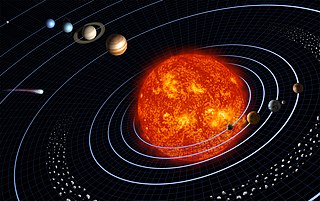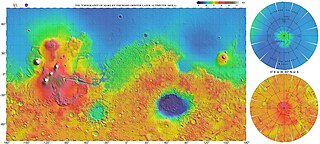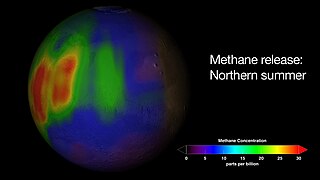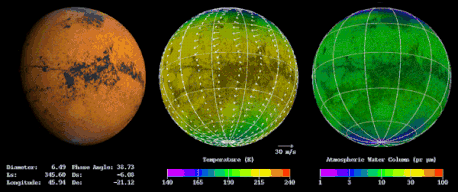A biosignature is any substance – such as an element, isotope, molecule, or phenomenon – that provides scientific evidence of past or present life on a planet. Measurable attributes of life include its complex physical or chemical structures, its use of free energy, and the production of biomass and wastes.

Elysium, located in the Elysium and Cebrenia quadrangles, is the second largest volcanic region on Mars, after Tharsis. The region includes the volcanoes Hecates Tholus, Elysium Mons and Albor Tholus. The province is centered roughly on Elysium Mons at 24.7°N 150°E. Elysium Planitia is a broad plain to the south of Elysium, centered at 3.0°N 154.7°E. Another large volcano, Apollinaris Mons, lies south of Elysium Planitia and is not part of the province. Besides having large volcanoes, Elysium has several areas with long trenches, called fossa or fossae (plural) on Mars. They include the Cerberus Fossae, Elysium Fossae, Galaxias Fossae, Hephaestus Fossae, Hyblaeus Fossae, Stygis Fossae and Zephyrus Fossae.

The atmosphere of Mars is the layer of gases surrounding Mars. It is primarily composed of carbon dioxide (95%), molecular nitrogen (2.85%), and argon (2%). It also contains trace levels of water vapor, oxygen, carbon monoxide, hydrogen, and noble gases. The atmosphere of Mars is much thinner and colder than Earth's having a max density 20g/m3 with a temperature generally below zero down to -60 Celsius. The average surface pressure is about 610 pascals (0.088 psi) which is less than 1% of the Earth's value.
The Mars Regional Atmospheric Modeling System (MRAMS) is a computer program that simulates the circulations of the Martian atmosphere at regional and local scales. MRAMS, developed by Scot Rafkin and Timothy Michaels, is derived from the Regional Atmospheric Modeling System (RAMS) developed by William R. Cotton and Roger A. Pielke to study atmospheric circulations on the Earth.

The climate of Mars has been a topic of scientific curiosity for centuries, in part because it is the only terrestrial planet whose surface can be easily directly observed in detail from the Earth with help from a telescope.
Thermophysics is the application of thermodynamics to geophysics and to planetary science more broadly. It may also be used to refer to the field of thermodynamic and transport properties.

The study of extraterrestrial atmospheres is an active field of research, both as an aspect of astronomy and to gain insight into Earth's atmosphere. In addition to Earth, many of the other astronomical objects in the Solar System have atmospheres. These include all the gas giants, as well as Mars, Venus and Titan. Several moons and other bodies also have atmospheres, as do comets and the Sun. There is evidence that extrasolar planets can have an atmosphere. Comparisons of these atmospheres to one another and to Earth's atmosphere broaden our basic understanding of atmospheric processes such as the greenhouse effect, aerosol and cloud physics, and atmospheric chemistry and dynamics.

The atmosphere of Titan is the dense layer of gases surrounding Titan, the largest moon of Saturn. Titan is the only natural satellite in the Solar System with an atmosphere that is denser than the atmosphere of Earth and is one of two moons with an atmosphere significant enough to drive weather. Titan's lower atmosphere is primarily composed of nitrogen (94.2%), methane (5.65%), and hydrogen (0.099%). There are trace amounts of other hydrocarbons, such as ethane, diacetylene, methylacetylene, acetylene, propane, PAHs and of other gases, such as cyanoacetylene, hydrogen cyanide, carbon dioxide, carbon monoxide, cyanogen, acetonitrile, argon and helium. The isotopic study of nitrogen isotopes ratio also suggests acetonitrile may be present in quantities exceeding hydrogen cyanide and cyanoacetylene. The surface pressure is about 50% higher than on Earth at 1.5 bars which is near the triple point of methane and allows there to be gaseous methane in the atmosphere and liquid methane on the surface. The orange color as seen from space is produced by other more complex chemicals in small quantities, possibly tholins, tar-like organic precipitates.

The ExoMars Trace Gas Orbiter is a collaborative project between the European Space Agency (ESA) and the Russian Roscosmos agency that sent an atmospheric research orbiter and the Schiaparelli demonstration lander to Mars in 2016 as part of the European-led ExoMars programme.

The most conspicuous feature of Mars is a sharp contrast, known as the Martian dichotomy, between the Southern and the Northern hemispheres. The two hemispheres' geography differ in elevation by 1 to 3 km. The average thickness of the Martian crust is 45 km, with 32 km in the northern lowlands region, and 58 km in the southern highlands.

The Mars ocean theory states that nearly a third of the surface of Mars was covered by an ocean of liquid water early in the planet's geologic history. This primordial ocean, dubbed Paleo-Ocean or Oceanus Borealis, would have filled the basin Vastitas Borealis in the northern hemisphere, a region that lies 4–5 km below the mean planetary elevation, at a time period of approximately 4.1–3.8 billion years ago. Evidence for this ocean includes geographic features resembling ancient shorelines, and the chemical properties of the Martian soil and atmosphere. Early Mars would have required a denser atmosphere and warmer climate to allow liquid water to remain at the surface.

Almost all water on Mars today exists as ice, though it also exists in small quantities as vapor in the atmosphere. What was thought to be low-volume liquid brines in shallow Martian soil, also called recurrent slope lineae, may be grains of flowing sand and dust slipping downhill to make dark streaks. While most water ice is buried, it is exposed at the surface across several locations on Mars. In the mid-latitudes, it is exposed by impact craters, steep scarps and gullies. Additionally, water ice is also visible at the surface at the north polar ice cap. Abundant water ice is also present beneath the permanent carbon dioxide ice cap at the Martian south pole. More than 5 million km3 of ice have been detected at or near the surface of Mars, enough to cover the whole planet to a depth of 35 meters (115 ft). Even more ice might be locked away in the deep subsurface. Some liquid water may occur transiently on the Martian surface today, but limited to traces of dissolved moisture from the atmosphere and thin films, which are challenging environments for known life. No evidence of present-day liquid water has been discovered on the planet's surface because under typical Martian conditions, warming water ice on the Martian surface would sublime at rates of up to 4 meters per year. Before about 3.8 billion years ago, Mars may have had a denser atmosphere and higher surface temperatures, potentially allowing greater amounts of liquid water on the surface, possibly including a large ocean that may have covered one-third of the planet. Water has also apparently flowed across the surface for short periods at various intervals more recently in Mars' history. Aeolis Palus in Gale Crater, explored by the Curiosity rover, is the geological remains of an ancient freshwater lake that could have been a hospitable environment for microbial life. The present-day inventory of water on Mars can be estimated from spacecraft images, remote sensing techniques, and surface investigations from landers and rovers. Geologic evidence of past water includes enormous outflow channels carved by floods, ancient river valley networks, deltas, and lakebeds; and the detection of rocks and minerals on the surface that could only have formed in liquid water. Numerous geomorphic features suggest the presence of ground ice (permafrost) and the movement of ice in glaciers, both in the recent past and present. Gullies and slope lineae along cliffs and crater walls suggest that flowing water continues to shape the surface of Mars, although to a far lesser degree than in the ancient past.

Lobate debris aprons (LDAs) are geological features on Mars, first seen by the Viking Orbiters, consisting of piles of rock debris below cliffs. These features have a convex topography and a gentle slope from cliffs or escarpments, which suggest flow away from the steep source cliff. In addition, lobate debris aprons can show surface lineations as do rock glaciers on the Earth.

Aeolis Mensae is a tableland feature in the northwest Aeolis quadrangle of Mars. Its location is centered at 2.9° south latitude and 219.6° west longitude, in the transition zone between the Martian highlands and lowlands. It is 820 kilometres (510 mi) long and was named after a classical albedo feature (Aeolis). The constituent mensae can be as long as 70 kilometres (43 mi) and as tall as 2 kilometres (1.2 mi). It is notable for being the origin of an abnormal concentration of methane detected by Curiosity in 2019, although its geology has attracted scientific attention since at least a decade before this event. Aeolis Mensae is also the first region in Mars where submarine cyclic steps, an erosion feature that gives evidence of an ancient ocean, were identified.
The NASA International Planetary Patrol Program consists of a network of astronomical observatories to collect uninterrupted images and observations of the large-scale atmospheric and surface features of the planets. This group was established in 1969, and consisted of the Mauna Kea Observatory, the Mount Stromlo Observatory, the Perth Observatory, the Republic Observatory, the Cerro Tololo Inter-American Observatory, the Magdalena Peak Station of the New Mexico State University, and the Lowell Observatory. The activities were coordinated by William A. Baum of Lowell Observatory. In the years from 1975 to 1981 the San Vittore Observatory (Bologna) Italy also participated with observations of Mars, Jupiter and Saturn.
The Regional Atmospheric Modeling System (RAMS) is a set of computer programs that simulate the atmosphere for weather and climate research and for numerical weather prediction (NWP). Other components include a data analysis and a visualization package.

Chemical cycling describes systems of repeated circulation of chemicals between other compounds, states and materials, and back to their original state, that occurs in space, and on many objects in space including the Earth. Active chemical cycling is known to occur in stars, many planets and natural satellites.

The reported presence of methane in the atmosphere of Mars is of interest to many geologists and astrobiologists, as methane may indicate the presence of microbial life on Mars, or a geochemical process such as volcanism or hydrothermal activity.
Atmospheric super-rotation is a phenomenon where a planet's atmosphere rotates faster than the planet itself. This behavior is observed in the atmosphere of Venus, atmosphere of Titan, atmosphere of Jupiter, and atmosphere of Saturn. Venus exhibits the most extreme super-rotation, with its atmosphere circling the planet in four Earth days, much faster than its planet's own rotation. The phenomenon of atmospheric super-rotation can influence a planet's climate and atmospheric dynamics.

The climate of Pluto concerns the atmospheric dynamics, weather, and long-term trends on the dwarf planet Pluto. Five climate zones are assigned on the dwarf planet: tropics, arctic, tropical arctic, diurnal, and polar. These climate zones are delineated based on astronomically defined boundaries or sub-solar latitudes, which are not associated with the atmospheric circulations on the dwarf planet. Charon, the largest moon of Pluto, is tidally locked with it, and thus has the same climate zone structure as Pluto itself.
















